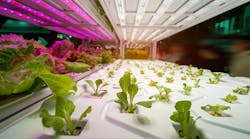The Lighting Research Center (LRC) at Rensselaer Polytechnic Institute, Troy, NY, published a new report on the energy and economic performance of LED horticultural luminaires. The research team found that for a given growing area, energy savings were possible with some of the tested LED horticultural luminaires compared to the tested high-pressure sodium (HPS) and metal halide (MH) horticultural luminaires, when meeting the same photosynthetic photon flux density (PPFD) criterion, but there was remarkably wide variation among products.
Moreover the study found that LED solutions created more problems by shading crops than legacy lighting systems. The LRC found that, on average, approximately three times as many LED horticultural luminaires would be needed to provide the same PPFD as a typical 1000-watt HPS horticultural luminaire layout.
The results of the evaluation show that stakeholders can be misled by considering luminaire efficacy alone, the study said. Rather, the luminaire intensity distribution and layout to reach a criterion PPFD are necessary for an accurate life-cycle cost analysis. The LRC said its report provides a technology-neutral framework that stakeholders can use to evaluate lighting systems.
“Upon analyzing our data, we were intrigued by how intensity distribution and layout emerged as key factors in system performance,” said LRC Research Scientist Leora Radetsky, who authored the report.
The LRC evaluated key factors such as power demand, life-cycle cost, luminaire intensity distribution, and luminaire shading. Of particular importance is the fact that the LRC considered the effectiveness of the entire lighting system for a controlled growing environment.
The shading from LED luminaires reduces daylight in a greenhouse by up to 55% compared with a 5% reduction in daylight from HPS luminaires, thus more electric energy could be needed for lighting with the LED systems, depending upon the available daylight.
In a recent LRC survey, 75% of growers identified the cost of LED horticultural lighting to be a barrier to adoption, therefore it was important to include a life-cycle cost analysis in the report. The LRC found that three of the tested LED horticultural luminaire lighting systems had lower life-cycle costs and the remaining seven had higher life-cycle costs than either of the two 1000-watt HPS lighting systems that were tested.
“Energy use and life-cycle costs vary widely among LED and HPS lighting systems used in controlled environment horticulture,” said Radetsky. “It has been the standard approach for many years in the field of architectural lighting, and is becoming readily apparent in horticultural lighting, that we must conduct complete system energy and life-cycle cost analyses to generate an accurate picture of which technology would work best for each particular application.”
Here's where to download the full report (PDF): LED and HID Horticultural Luminaire Testing Report



